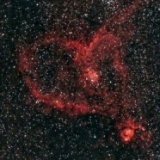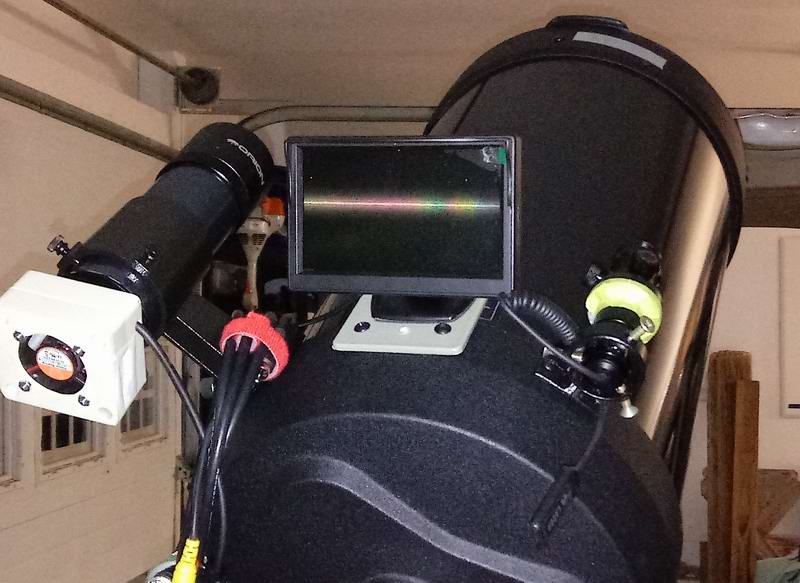INDI Library v2.0.7 is Released (01 Apr 2024)
Bi-monthly release with minor bug fixes and improvements
PHD2 and EKOS interaction
- Ronald Scotti
-
 Topic Author
Topic Author
- Offline
- Elite Member
-

- Posts: 396
- Thank you received: 17
PHD2 and EKOS interaction was created by Ronald Scotti
Here is how I tried: EKOS is up and running with all equipment. I have selected external guiding with PHD2 in the profile. I get to a point where I would like to start guiding. (Polar aligned and pointing at some object). I start PHD2 and connect to equipment. I have selected the INDI Camera (SX CCD Lodestar and for the Mount I select "on Camera," as I have connected the cable from the Lodestar to the AUX GUide port on the mount. Note: if I use the manual guide buttons in PHD2 I can see the mount move both in the hand controller info and with a star in the camera. So I know their are signals getting to the mount using the AUX guide port.
(Question) BUT what I don't know is if in this configuration does any mount info get back to PHD2?
I tried running the PHD2 'star cross' test. Where is says to start a long exposure (unguided) and it will send signals to the mount to create a cross image of the star (moving West - East - North - South with 15 pulses in each direction every few seconds), but the PHD2 runs thru that routine in about 10 seconds instead of the 2 minutes it was supposed to take. The exposure shows no star pattern of course.
(NOTE): I need to try this again with the mount selection in PHD2 as the CGEM mount thru the hand controller to see if it behaves differently. ( I think I may have tried that last night, but I don't recall and I need to look thru the PHD2 logs)
(Main Question): is that once PHD2 is connected to the equipment and I have connected to it in the EKOS guide module, can I use the full functionality of the PHD2 commands in its window or am I limited only to 'guiding' with PHD2? And from the previous question, does mount info always get back to PHD2 from EKOS or do I need to have the "Mount" selection in PHD2 thru the hand controller and not thru the "on camera?"
I have asked this question on the PHD2 OpenGuiding forum, but I thought I should as it here as well.
thanks,
Ron
Please Log in or Create an account to join the conversation.
- Ronald Scotti
-
 Topic Author
Topic Author
- Offline
- Elite Member
-

- Posts: 396
- Thank you received: 17
Replied by Ronald Scotti on topic PHD2 and EKOS interaction
I will try again tonight.
thanks,
Ron
Please Log in or Create an account to join the conversation.
Replied by Andrew on topic PHD2 and EKOS interaction
Please Log in or Create an account to join the conversation.
- Peter Sütterlin
-

- Offline
- Supernova Explorer
-

- Posts: 1009
- Thank you received: 133
Replied by Peter Sütterlin on topic PHD2 and EKOS interaction
As for the TO: No, EKOS is not intending to make use of anything else of PHD2 than the guiding function. You need to use PHD2 itself if you want the tools etc.
Please Log in or Create an account to join the conversation.
- Ronald Scotti
-
 Topic Author
Topic Author
- Offline
- Elite Member
-

- Posts: 396
- Thank you received: 17
Replied by Ronald Scotti on topic PHD2 and EKOS interaction
thanks again,
Ron
Please Log in or Create an account to join the conversation.
- Jose Corazon
-

- Offline
- Supernova Explorer
-

- Posts: 1119
- Thank you received: 182
Replied by Jose Corazon on topic PHD2 and EKOS interaction
I would be interested in the nature of the problems you encounter with the internal guider, Ron. Can you elaborate a little more on those?
For me, these are mount-specific, i.e. I encounter problems with my iOptron mount, but not with my Atlas mount. It would be great if those issue could be sorted out, the internal guider is so much more convenient in so many ways than PhD2.
Best
Jo
Please Log in or Create an account to join the conversation.
- Ronald Scotti
-
 Topic Author
Topic Author
- Offline
- Elite Member
-

- Posts: 396
- Thank you received: 17
Replied by Ronald Scotti on topic PHD2 and EKOS interaction
I have proof of everything working, a couple of weeks ago I was able to take 10 minute subs with round stars (using the internal guider) on my f/10 setup, which I thought was exceptional. So if I can just get it working, I know it should work well. Of course, that discounts any periodic error my mount may have. I may have just found the sweet spot in the gears that night!
If I figure anything out I will let you know.
Ron
Please Log in or Create an account to join the conversation.
- Jose Corazon
-

- Offline
- Supernova Explorer
-

- Posts: 1119
- Thank you received: 182
Replied by Jose Corazon on topic PHD2 and EKOS interaction
Polaris will always be in the frame and you can come down to 30" just with the PoleMaster alone, although that is the absolute limit.
Nonetheless, you will almost certainly be within 1 or 2', and at that deviation from the CP you can use your main camera or your guide cam for a second fine-tuning run.
I first thought the PoleMaster was a waste of money, but now I don't want to miss it anymore. It makes PA really easy and a snap.
Also, consider using the new guide calibration feature that is now available in the guide module (in Nightly). It will tell you right away how good your calibration is and whether you need more calibration steps and longer guide pulses.
Please Log in or Create an account to join the conversation.
- Ronald Scotti
-
 Topic Author
Topic Author
- Offline
- Elite Member
-

- Posts: 396
- Thank you received: 17
Replied by Ronald Scotti on topic PHD2 and EKOS interaction
I went thru the baseline calibration of PHD2 tonight and the scope now seems to be guiding ok. I just had to get all the equipment connected correctly and make a few adjustments.
I think I am making progress thanks to the developers here and the support here and at PHD2.
thanks all,
ron
Please Log in or Create an account to join the conversation.
- Jose Corazon
-

- Offline
- Supernova Explorer
-

- Posts: 1119
- Thank you received: 182
Replied by Jose Corazon on topic PHD2 and EKOS interaction
Clearly, you like to tinker yourself and you seem to have a 3D printer to make all sorts of adapters.
In that case, you might want to consider another solution:
Use your Sony and couple it to a cheap used DSLR lens, like this one:
smile.amazon.com/INDUSTAR-LEICA-Soviet-R...id=6461714011&sr=8-1
That will increase your FOV and make it similar to the PoleMaster. Then place camera directly on the rotational axis of your mount where the FOV is unobstructed.
That will make PA easy and fast.
Please Log in or Create an account to join the conversation.
- Ronald Scotti
-
 Topic Author
Topic Author
- Offline
- Elite Member
-

- Posts: 396
- Thank you received: 17
Replied by Ronald Scotti on topic PHD2 and EKOS interaction
Tonight I connected PHD2 to the mount only thru the hand controller and I performed their recommended Baseline calibration. All went pretty well and guiding tonight was much better. I was able to again achieve 10 minute round stars. But (there always is a but), everytime I use the EKOS guide button to activate PHD2 guiding, it wants to do a calibration first. I would slew to a target , hit start guiding in EKOS and it would start a calibration. By the time the calibration was done I was no longer on target. So I would have to slew (or move) to the target again, hit start guiding and it would start another calibration. I was getting nowhere fast. Finally, I disconnected PHD2 from EKOS and used it as a separate program for guiding. PHD2 did not do a new calibration each time, it went right into guiding. So there is something not quite right about how PHD2 is 'integrated' with EKOS. I could use EKOS to take the images, but I had to use PHD2 on its own to guide. I am afraid this is also the case with the internal guider, it always starts with a calibration and by the time that is done, the setup is no longer on target. These are the issues with imaging at f/10, the target is small and scope moves off target quickly.
Ron
Please Log in or Create an account to join the conversation.
- Peter Sütterlin
-

- Offline
- Supernova Explorer
-

- Posts: 1009
- Thank you received: 133
Replied by Peter Sütterlin on topic PHD2 and EKOS interaction
Ha, that was something I was thinking of myself, too: Can't you just use some INDI-supported webcam with some better lens, mount it on the RA axis, and use that in the EKOS PA routine for alignment? Do you use the Polemaster software for alignment, or EKOS? I know there's also some Linux-version of the polemaster software, I have it installed here, but without the hardware that doesn't help much
Please Log in or Create an account to join the conversation.

